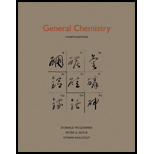
General Chemistry
4th Edition
ISBN: 9781891389603
Author: Donald A. McQuarrie, Peter A. Rock, Ethan B. Gallogly
Publisher: University Science Books
expand_more
expand_more
format_list_bulleted
Concept explainers
Question
Chapter 13, Problem 13.11P
Interpretation Introduction
Interpretation:
The balanced chemical equation that illustrates the combination of gases X and Y to form new gas has to be written.
Concept Introduction:
Gay-Lussac’s gaseous law states that ratio of gaseous volumes that combine in
Expert Solution & Answer
Want to see the full answer?
Check out a sample textbook solution
Students have asked these similar questions
Identify each chiral carbon as either R or S. Identify the overall carbohydrates as L or D
Ethers can be formed via acid-catalyzed acetal formation. Draw the mechanism for the molecule below and ethanol.
HOCH,
H
HO
CH-OH
OH H
OH
11
CH₂OH
F
II
OH H
H
0
+
H OH
Chapter 13 Solutions
General Chemistry
Ch. 13 - Prob. 13.1PCh. 13 - Prob. 13.2PCh. 13 - Prob. 13.3PCh. 13 - Prob. 13.4PCh. 13 - Prob. 13.5PCh. 13 - Prob. 13.6PCh. 13 - Prob. 13.7PCh. 13 - Prob. 13.8PCh. 13 - Prob. 13.9PCh. 13 - Prob. 13.10P
Ch. 13 - Prob. 13.11PCh. 13 - Prob. 13.12PCh. 13 - Prob. 13.13PCh. 13 - Prob. 13.14PCh. 13 - Prob. 13.15PCh. 13 - Prob. 13.16PCh. 13 - Prob. 13.17PCh. 13 - Prob. 13.18PCh. 13 - Prob. 13.19PCh. 13 - Prob. 13.20PCh. 13 - Prob. 13.21PCh. 13 - Prob. 13.22PCh. 13 - Prob. 13.23PCh. 13 - Prob. 13.24PCh. 13 - Prob. 13.25PCh. 13 - Prob. 13.26PCh. 13 - Prob. 13.27PCh. 13 - Prob. 13.28PCh. 13 - Prob. 13.29PCh. 13 - Prob. 13.30PCh. 13 - Prob. 13.31PCh. 13 - Prob. 13.32PCh. 13 - Prob. 13.33PCh. 13 - Prob. 13.34PCh. 13 - Prob. 13.35PCh. 13 - Prob. 13.36PCh. 13 - Prob. 13.37PCh. 13 - Prob. 13.38PCh. 13 - Prob. 13.39PCh. 13 - Prob. 13.40PCh. 13 - Prob. 13.41PCh. 13 - Prob. 13.42PCh. 13 - Prob. 13.43PCh. 13 - Prob. 13.44PCh. 13 - Prob. 13.45PCh. 13 - Prob. 13.46PCh. 13 - Prob. 13.47PCh. 13 - Prob. 13.48PCh. 13 - Prob. 13.49PCh. 13 - Prob. 13.50PCh. 13 - Prob. 13.51PCh. 13 - Prob. 13.52PCh. 13 - Prob. 13.53PCh. 13 - Prob. 13.54PCh. 13 - Prob. 13.55PCh. 13 - Prob. 13.56PCh. 13 - Prob. 13.57PCh. 13 - Prob. 13.58PCh. 13 - Prob. 13.59PCh. 13 - Prob. 13.60PCh. 13 - Prob. 13.61PCh. 13 - Prob. 13.62PCh. 13 - Prob. 13.63PCh. 13 - Prob. 13.64PCh. 13 - Prob. 13.65PCh. 13 - Prob. 13.66PCh. 13 - Prob. 13.67PCh. 13 - Prob. 13.68PCh. 13 - Prob. 13.69PCh. 13 - Prob. 13.70PCh. 13 - Prob. 13.71PCh. 13 - Prob. 13.72PCh. 13 - Prob. 13.73PCh. 13 - Prob. 13.74PCh. 13 - Prob. 13.75PCh. 13 - Prob. 13.76PCh. 13 - Prob. 13.77PCh. 13 - Prob. 13.78PCh. 13 - Prob. 13.79PCh. 13 - Prob. 13.80PCh. 13 - Prob. 13.81PCh. 13 - Prob. 13.82PCh. 13 - Prob. 13.83PCh. 13 - Prob. 13.84PCh. 13 - Prob. 13.85PCh. 13 - Prob. 13.86PCh. 13 - Prob. 13.87PCh. 13 - Prob. 13.88PCh. 13 - Prob. 13.89PCh. 13 - Prob. 13.90PCh. 13 - Prob. 13.91PCh. 13 - Prob. 13.92PCh. 13 - Prob. 13.93PCh. 13 - Prob. 13.94P
Knowledge Booster
Learn more about
Need a deep-dive on the concept behind this application? Look no further. Learn more about this topic, chemistry and related others by exploring similar questions and additional content below.Similar questions
- Draw the mechanism for the formation of diol by starting with one pen and all in... basic conditions then acidic conditions then draw the mechanism for the formation of a carboxylic acid from your product.arrow_forwardDraw the mechanism for the oxidation of 3-bromo-cyclohexan-1-ol.arrow_forwardConvert the following Fischer projection to Haworth projections. show work and show the arrows please.arrow_forward
- Draw the mechanism for the substitution reaction converting an alcohol into an alkyl halide. If chirality is important to the reaction include it.arrow_forwardWrite, in words three different reactions we can use to make an alcohol.arrow_forwardDraw the reduction mechanism for the reduction of the aldehyde.arrow_forward
arrow_back_ios
SEE MORE QUESTIONS
arrow_forward_ios
Recommended textbooks for you
 ChemistryChemistryISBN:9781305957404Author:Steven S. Zumdahl, Susan A. Zumdahl, Donald J. DeCostePublisher:Cengage Learning
ChemistryChemistryISBN:9781305957404Author:Steven S. Zumdahl, Susan A. Zumdahl, Donald J. DeCostePublisher:Cengage Learning ChemistryChemistryISBN:9781259911156Author:Raymond Chang Dr., Jason Overby ProfessorPublisher:McGraw-Hill Education
ChemistryChemistryISBN:9781259911156Author:Raymond Chang Dr., Jason Overby ProfessorPublisher:McGraw-Hill Education Principles of Instrumental AnalysisChemistryISBN:9781305577213Author:Douglas A. Skoog, F. James Holler, Stanley R. CrouchPublisher:Cengage Learning
Principles of Instrumental AnalysisChemistryISBN:9781305577213Author:Douglas A. Skoog, F. James Holler, Stanley R. CrouchPublisher:Cengage Learning Organic ChemistryChemistryISBN:9780078021558Author:Janice Gorzynski Smith Dr.Publisher:McGraw-Hill Education
Organic ChemistryChemistryISBN:9780078021558Author:Janice Gorzynski Smith Dr.Publisher:McGraw-Hill Education Chemistry: Principles and ReactionsChemistryISBN:9781305079373Author:William L. Masterton, Cecile N. HurleyPublisher:Cengage Learning
Chemistry: Principles and ReactionsChemistryISBN:9781305079373Author:William L. Masterton, Cecile N. HurleyPublisher:Cengage Learning Elementary Principles of Chemical Processes, Bind...ChemistryISBN:9781118431221Author:Richard M. Felder, Ronald W. Rousseau, Lisa G. BullardPublisher:WILEY
Elementary Principles of Chemical Processes, Bind...ChemistryISBN:9781118431221Author:Richard M. Felder, Ronald W. Rousseau, Lisa G. BullardPublisher:WILEY

Chemistry
Chemistry
ISBN:9781305957404
Author:Steven S. Zumdahl, Susan A. Zumdahl, Donald J. DeCoste
Publisher:Cengage Learning

Chemistry
Chemistry
ISBN:9781259911156
Author:Raymond Chang Dr., Jason Overby Professor
Publisher:McGraw-Hill Education

Principles of Instrumental Analysis
Chemistry
ISBN:9781305577213
Author:Douglas A. Skoog, F. James Holler, Stanley R. Crouch
Publisher:Cengage Learning

Organic Chemistry
Chemistry
ISBN:9780078021558
Author:Janice Gorzynski Smith Dr.
Publisher:McGraw-Hill Education

Chemistry: Principles and Reactions
Chemistry
ISBN:9781305079373
Author:William L. Masterton, Cecile N. Hurley
Publisher:Cengage Learning

Elementary Principles of Chemical Processes, Bind...
Chemistry
ISBN:9781118431221
Author:Richard M. Felder, Ronald W. Rousseau, Lisa G. Bullard
Publisher:WILEY